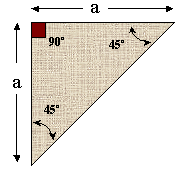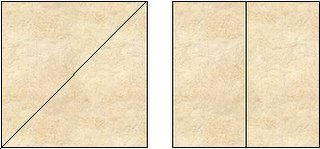A HOBBY OF DECISIONS
INTROITO
Dear reader: I remind you that these are my notes about how am I learning everything related to the resolutions of the CPs. Pardon me for any error I commit, specially related to the pictures, the handling of the html language and the images, which I am still in process of learning its management. I learn more every day!
FIRST PART
Dear reader: I remind you that these are my notes about how am I learning everything related to the resolutions of the CPs. Pardon me for any error I commit, specially related to the pictures, the handling of the html language and the images, which I am still in process of learning its management. I learn more every day!
FIRST PART
THE MYSTERIES OF ROMAN
Some time ago, I showed 2 beautiful CPs form the Origamist (Román Díaz), and also indicated that there were big mysteries that are hidden in its lines. To begin to understand the CPs, I would like to show you one of those big mysteries. For it, click on the image that says BASE.
--------------CP____________________BASE----------
That’s it! One of the big mysteries hidden in between the lines of the CPs is the final model of the creator (In the last entry, Introduction and definition of CP, if you choose the other CP, the other model of Román will be revealed).
To tell the truth, the final model is there like a butterfly in its cocoon. And why do I express myself this way? It’s because it is of great importance that we understand the CPs very well, and this way we establish our proper limits for our hobby.
Usually, the CP only takes us to what we call the BASE. In the origami terminology, the base of a model is a step in the sequence of folding in which a figure is obtained with the same number, distribution and size of tips of main flaps as the final model. Sometimes, this figure will look like the final model, but generally it won’t. So to get into this wonderful hobby, which is the resolution of the CPs, we most first take away the wish to obtain with them the final model of the creator. Of course, depending of each ones skills and knowledge, many will get to the final model by means of origami techniques; but that is out of reach in this blog.
In very particular cases, we get to find origami creators that are very “kind with us” in which CPs get us very close to the final model, but that is not very common. So as said before, usually the CP takes us to the base, of some place between the base and the final model; but definitely never before the base.
I like to think of the base! I consider it as an embryo of the final model. In the CP-embryo is everything necessary of structurally important (see definition of CP in th Introductions) to obtain the final figure, but it’s always missing something more! It still has to grow, develop, define and form the details, that, by this way, finally to be born. The CPs are beautiful with its symmetries, vertices, which irradiate multiple rays, forming stars and the final model is great, with its representation; but the base, seems for me as ugly as an embryo. Many people, looking at the CP feels attracted to solve it and seeing the final model wishes to obtain it, but only a few “relatively knowing the truth” persist on wearing away their mind for the pure love towards the “ugly” embryo.
SECOND PART:
To tell the truth, the final model is there like a butterfly in its cocoon. And why do I express myself this way? It’s because it is of great importance that we understand the CPs very well, and this way we establish our proper limits for our hobby.
Usually, the CP only takes us to what we call the BASE. In the origami terminology, the base of a model is a step in the sequence of folding in which a figure is obtained with the same number, distribution and size of tips of main flaps as the final model. Sometimes, this figure will look like the final model, but generally it won’t. So to get into this wonderful hobby, which is the resolution of the CPs, we most first take away the wish to obtain with them the final model of the creator. Of course, depending of each ones skills and knowledge, many will get to the final model by means of origami techniques; but that is out of reach in this blog.
In very particular cases, we get to find origami creators that are very “kind with us” in which CPs get us very close to the final model, but that is not very common. So as said before, usually the CP takes us to the base, of some place between the base and the final model; but definitely never before the base.
I like to think of the base! I consider it as an embryo of the final model. In the CP-embryo is everything necessary of structurally important (see definition of CP in th Introductions) to obtain the final figure, but it’s always missing something more! It still has to grow, develop, define and form the details, that, by this way, finally to be born. The CPs are beautiful with its symmetries, vertices, which irradiate multiple rays, forming stars and the final model is great, with its representation; but the base, seems for me as ugly as an embryo. Many people, looking at the CP feels attracted to solve it and seeing the final model wishes to obtain it, but only a few “relatively knowing the truth” persist on wearing away their mind for the pure love towards the “ugly” embryo.
SECOND PART:
THE EASIEST CPS AND THEIR UNCERTAINTY
The two figures of origami, with the easiest CPs that exist, helps us represent mountains, volcanoes, roofs, books, doors, and thousands of things. They are of great antique and its origins are lost in the fog of the documented history. Showing them would seem trivial, but, as the inductive method shows us, the simple things helps us understand the complicated. In these two CPs are contained various fundamental concepts that will be fully used in the resolution of the CPs each time more complicated. Let’s see the CPs sketched on a square piece of paper:
(Fig. 1) CP1: Bisector_______(Fig.2) CP2: Perpendicular Bisector
The line of CP1 is denominated Bisector or Diagonal and it cuts the right angle, of the two opposite corners, exactly in angles of 45º. The figures at each side of the bisector are two isosceles right triangles, each one of them with half the area of the original square (For primary teachers, this can serve as a visual method for the teaching of geometry! This blog will contain many elements that could be useful). Let’s watch it more detailed so it gets clearer:


(Fig. 3) Divided Square _______(Fig. 4) The separated triangle
It’s a right triangle because it contains one angle of 90º, and it is isosceles since it has two equal sides.
The recognition of basic geometric figures and the mathematics concepts that rules them will be a fundamental part in the process of the resolution of the CPs. We will go little by little identifying them one by one.
By now I would just like to show you, so that you remember them, the types of triangle that exists:
(Fig. 5) Types of Triangles
Going back to the simplest CPs, figure 2 shows us the perpendicular bisector. It cuts the side of the square in two, generating two rectangles, each one with the area of the original square.
(Fig. 6) Rectangles
Now, let’s take a square piece of paper and do Origami (meaning to fold paper in Japanese). Let’s fold CP1! Then the first question we make is:
RIDDLE NO. 1
In what direction do we fold it?
I wanted to jut out this question because of its fundamental importance. The direction of the fold is the first of the great riddles in the resolution of the CPs. For each line in a CP there are only two folding options, towards (to the front) or backwards (to the back); very little, but we have to DECIDE! I call this ambiguity the FIRST SPATIAL UNCERTAINTY: the CP does not give us the certainty of the folding direction. But before we thoroughness analyze the first spatial uncertainty, we have to establish some more basic elements.
Even relatively little frequent, some origami creators show us the CP with the first riddle solved, since it shows ust the direction of each of the folds. In this case the CP is named CPMV which means CP WITH ASSIGNED MOUNTAIN AND VALLIES. Let’s watch what we refer in the easiest CPs. We are going to draw two diagonal CPMV. For that we use the symbolic notation of the origami:
(Fig. 7) CPMV: valley ________ (Fig. 8) CPMV: mountain
Then, figure seven and eight indicates us the direction of the folds, the first one a valley, and the second one a mountain. Now let’s see the diagrams of these CPMV:
(Fig. 9) Valley diagram _______ (Fig. 10) Mountain diagram
As you can see, to obtain the diagrams we just add arrows. . Now it reads like this: for figure 9 “fold the diagonal towards the front”, and for figure 10: “fold the diagonal backwards (to the back)”. Let’s do it with paper! If the paper is two color sided, we will have to consider if we want the selected color inside or outside. But for now we are not going to consider this variable and we will think the it has same color both sides.
Ok, we made it! As you can observe, for the case of single line, the direction of the fold is indifferent. Trivial for now!
Everything we have written till now serves also, and of the same way, for the CP of the perpendicular bisector. For both CPs, bisector and perpendicular bisector, and for both lines, valley or mountain, the figures obtained are shown in these diagrams:
(Fig. 11) Isosceles right triangle ___________ (Fig. 12) Rectangle
We have obtained these two basic geometric figures and I would like to indicate one more concept in the resolution to the CPs using them. If we consider the paper as a plane, we these figures are really three-dimensional, but it is common in origami to say that they are flat. So, I would like to call them MULTICAPS FLAT FIGURES, to differentiate them from the plane; but also to differentiate them from the origami figures that are really Three-dimensional, which we call 3D FIGURES
If the CPs are like the embryos of the origami models; sure the bisector or the perpendicular bisector will be the vertebral spine. They are “structurally important” lines and, for me, the first references in resolving CPs. We will dedicate to the topic of references later one. For now, we ask ourselves:
What will happen to the simplest CPs if we incorporate a new line? What variables and riddles will be proposed as challenges? Let’s have patience, that going slow get us long and sure.
Your comments are extremely important in this blog; please write them below. Don’t worry if you don’t have an account nor password, just click on anonymous, and there you can write your message.
If you wish a copy of this document in pdf format, ask me for it at eric@internetelfaro.com, that I will be glad to send it to you.









